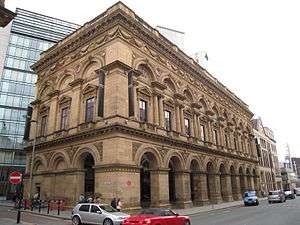Edward Walters

Edward Walters (December 1808, Fenchurch Buildings, London - 22 January 1872, 11 Oriental Place, Brighton) was an English architect.
Life
Walters was the son of an architect who died young. He began his career in the office of Isaac Clarke, his father's former assistant, before going to work with Lewis Vulliamy and then Sir John Rennie.[1] After superintending Rennie's military building work in Constantinople between 1832 and 1837, he returned to England to practise as an architect in the provinces. His practice was based at Manchester from 1839, where his most notable work was the Free Trade Hall, referred to as the "noblest monument in the Cinquecento style in England" by Nikolaus Pevsner.
Walters retired in 1865 and then travelled in Italy and England before his death in 1872. He never married and died without issue.
Manchester works (selected)
- Harvest House at 14 and 16, Mosley Street was built as a textile warehouse for Richard Cobden in 1839 in red brick in Flemish bond with sandstone dressings the Italian palazzo style. It was later altered to become shops.[2]
- Silas Schwabe's Warehouse (1845: demolished), Italian Renaissance Revival style
- The Firs, Fallowfield, was built for Joseph Whitworth in 1850.[3]
- Brown & Son's Warehouse, 9 Portland Street (1851 to 1852: demolished), Italian Renaissance Revival style. "A splendid example of the Manchester warehouse of the mid-century".[4]
- Four warehouses, south-east side of Piccadilly Gardens (1851-1858)
- Free Trade Hall (1855), in Peter Street, Italian Renaissance Revival style.[5]
- Castlefield Congregational Chapel (1858) in Castlefield, Victorian red-brick
- 38 and 42 Mosley Street, the Manchester & Salford (later William Deacon's, now RBS) Bank, Mosley Street, Renaissance Revival style (1860).[6]
References
- ↑ I'Anson, Edward (1872). "The Late Edward Walters, architect, of Manchester". Papers Read at the Royal Institute of British Architects. London. p. 113.
- ↑ Historic England. "Harvest House (1220153)". National Heritage List for England. Retrieved 20 April 2012.
- ↑ Historic England. "The Firs and attached Annex (1270605)". National Heritage List for England. Retrieved 11 September 2012.
- ↑ Sharp, D. (ed.) (1969) Manchester. (City Buildings Series.) London: Studio Vista; pp. 19-20
- ↑ Historic England. "Free Trade Hall (1246666)". National Heritage List for England. Retrieved 20 April 2012.
- ↑ Historic England. "Royal Bank Of Scotland, 38 and 42 Mosley Street (1220165)". National Heritage List for England. Retrieved 20 April 2012.
Further reading
- Architecture and Landscaping: a dictionary of architecture and landscape architecture. 1999, 2006 by Oxford University Press.
- Pevsner, N. (1969) Buildings of England, South Lancashire. Penguin Books
External links
- "Walters, Edward". Oxford Dictionary of National Biography (online ed.). Oxford University Press. doi:10.1093/ref:odnb/28642. (Subscription or UK public library membership required.). The first edition of this text is available as an article on Wikisource:
 "Walters, Edward". Dictionary of National Biography. London: Smith, Elder & Co. 1885–1900.
"Walters, Edward". Dictionary of National Biography. London: Smith, Elder & Co. 1885–1900.